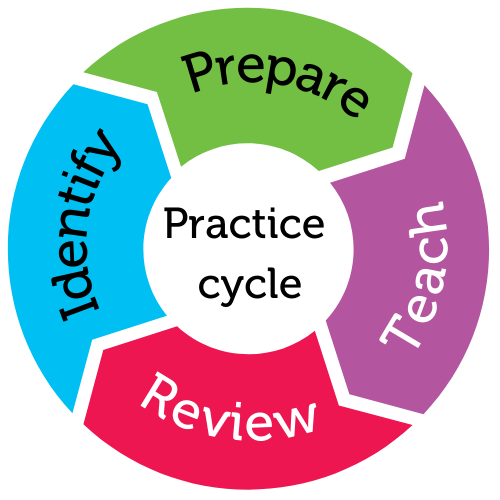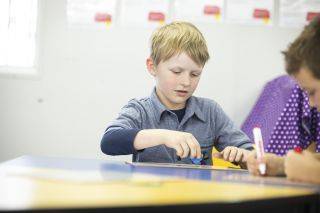
For student year
Preschool – Year 12
Helps students to
Helps teachers to
Summary
Some students find it challenging to carry out routine instructions. They need clear predictable routines to help them understand what they need to do. Knowing what will happen, when, and in what order can help reduce some of the anxiety students experience.
There is a difference between routines and schedules.
- A routine is a sequence of actions that make up a regular activity.
- Routines are typically explicitly taught using schedules at the beginning of the year.
- A schedule shows the sequence of activities that make up a session, the day or the week.
- Visual schedules are a visual display of a sequence of activities.
- Visual routines are a pictorial display of the actions required to complete a routine task, such as unpacking a bag or packing up classroom equipment.
Using visual schedules and routines helps your students to know what is coming next, and the sequence of actions required to adequately complete a task.
This practice focuses on why consistency improves the efficacy of visual schedules and routines. It is to be used in conjunction with the Using visual schedules practice.
How this practice works
Watch this video for more information.
Duration: 2:46
Australian Professional Standards for Teachers related to this practice
4.1 - support student participation
4.2 - manage classroom activities
For further information, see Australian Professional Standards for Teachers AITSL page
Preparing to teach
How does it help?
Classroom routines are predictable and consist of a frequently repeated sequences of activities that remain the same even when the content of the lesson or the instructional format alters. Providing visual schedules to communicate the sequence of upcoming activities or events is embedded as a component of classroom routine. Schedules indicate both what is the same and what is different in the current or upcoming lessons, as such, visual schedules assist students to cope with change.
Consistent routines enable you to:
- enhance structure
- provide predictability
- increase students’ ability to focus
- increase students’ ability to stay on-task (your students will know what to and how to do it)
Routines can include:
- packing the school bag
- putting away equipment before lunch
- eating lunch
- packing up the art room
- packing up and putting away manual arts or design technologies equipment
- preparing or cleaning up the home economics room
- packing up and putting away sporting equipment
How does consistently using routines and schedules support inclusive classrooms?
Visual schedules and routines are helpful for all students, regardless of need or diagnosis.
Think about how much you rely on diaries or planners to organise your day and how knowing what comes next makes you feel comforted. It’s the same for your students.
Using these tools consistently provides predictability, and gives students boundaries and expectations to uphold in the classroom.
Why is consistency so important?
Consistency is key to establishing a new behaviour or expectation in the classroom. Attempting a new strategy without sticking to it means you'll have difficulty determining if it has been successful or not. The length of time for a ‘trial’ is also dependent on your students’ abilities.
The balance, order, and tempo of activities/events should be considered when developing class and/or individual schedules. Consider the student’s attention span and when they are most alert.
When preparing a visual schedule or routine, think about the information that must be included, and how you can make it accessible.
| Information | Accessibility |
|
|
Consider where it will be placed in the room and how you will use it.
It works better if:
- the schedule, including upcoming changes, is available at the beginning of each class
- attention is drawn to what is staying the same as well as what is different
- students are positively reinforced for following a routine and for accepting change
- the independent use of schedules is encouraged by fading cues over time
- some students are provided with both a whole-class schedule and an individual schedule i.e., individual schedules move with students across settings
- schedules are adjusted to be less demanding if a student is stressed or just having a bad day.
It doesn’t work if:
- the form of representation used is inconsistent with the learning preferences of the student, e.g., cartoons are used when a student would prefer written words;
- the schedule is long and complex or changes often
- the students don’t understand the purpose of the schedule or routine
- it is not updated
- it is not referred to frequently
In the classroom
How do I do it?
- Show students the visual schedule or routine at the beginning of each day or before the routine activity is due to occur (such as preparing for library class).
- Display the visual schedule in a prominent position - ensure that it is easy to see by providing empty space around the schedule. Schedules that are surrounded by lots of visual materials are more difficult to focus on and notice in the room.
- If possible, show and forewarn students about any changes to the schedule at the beginning of the day.
- Consistently refer to the visual schedule or routine, particularly to support the transition to the next activity/event.
- Encourage and monitor student use of the visual schedules.
- Reinforce those students who follow the schedule or routine.
- Show changes to the schedule when required – if forewarning isn’t possible, be sure to introduce the change via the schedule ‘in the moment’.
- Remove/cross off schedule items as activities are finished to provide activity ‘closure’ and show progress through the day’s plan.
Why is this going to be effective?
When students know what is coming next and when, they can better prepare themselves to complete a current activity and move onto a new activity.
Using routines and schedules consistently may result in a decrease in off-task behaviour, and an increase in independence. (e.g., students are aware that spelling time means to go collect spelling books and dictionaries).
Using visual schedules and routines in a consistent way also improves the likelihood that these behaviours are adopted, and supports students to be aware of and understand expectations.
How will I know if it's working?
- Students use the visual schedule
- There is an increase in student comprehension of the sequence of classroom activities and a decrease in student anxiety.
- Students move more independently through classroom activities, initiate tasks more quickly, and are flexible about change.
Practice toolkit
Practice implementation planner template
We know that it is not always easy to keep track of what is working and what is not. So, we have created this template for you to record and reflect on what you are doing to help you create a more inclusive classroom. The implementation planner contains:
- Guidance around goal setting
- Reflection section (What worked, didn’t work and what to change and next steps.)
- Prompting questions
Implementation planner template
Implementation planner with examples
Set your professional learning goal for:
Consistently use routines and schedules
You can set and save your goal for inclusive practices using inclusionED. Saved goals will appear in your profile. Here you can access, refine and review your goal easily.
Benefits of goal setting
Setting, working towards, and reflecting on goals helps you grow professionally and improve your practice. You can access AITSL learning resources for teachers to learn more about:How to set goals
The Australian Institute for Teaching and School Leadership recommends using the SMART matrix to frame your goal setting.SMART goals refers to goals that are:
- Specific
- Measurable
- Achievable
- Relevant
- Time-phased
Resources
Consistently use routines and schedules - Practice Brief
Further reading
Materials informing the practice
Center on the Social and Emotional Foundations for Early Learning [CSEFEL]. (2013). Inventory of practice for supporting social-emotional competence.http://csefel.vanderbilt.edu/modules/module1/handout4.pdf
Iovannone, R., Dunlap, G., Huber, H., & Kincaid, D. (2003). Effective educational practices for students with autism spectrum disorders. Focus on Autism and Other Developmental Disabilities, 18(3), 150-165.
Simpson, R., & Crutchfield, S. (2013). Effective educational practices for children and youth with autism spectrum disorders: Issues, recommendations, and trends. In B. G. Cook, M. Tankersley, & T. J. Landrum (Eds.), Evidence-based practices (Advances in Learning and Behavioral Disabilities, Vol. 26, pp. 197-220): Emerald Group. doi:10.1108/S0735-004X(2013)0000026011
Related Practices

Use visual schedules
TEACHING PRACTICE
For student years
Preschool – Year 12
Helps students to
This practice is from the core research project
Learning Cycle

Set your practice implementation goal
Record your practice goal and reflections. Use the practice implementation template to help you identify your practice goal
Evidence
This practice was developed as part of the Early years behaviour support project. More information about the evidence informing this practice is available on the project page.
Off
